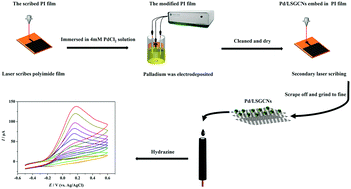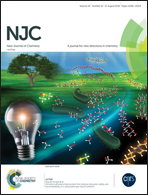Electrochemical sensor based on palladium loaded laser scribed graphitic carbon nanosheets for ultrasensitive detection of hydrazine†
Abstract
We propose a simple and inexpensive technique based on laser graphenization of polyimide (PI) sheets for the fabrication of graphitic carbon nanosheets in just a few minutes. We synthesized laser scribed graphitic carbon nanosheets loaded with palladium nanoparticles (Pd/LSGCNs) quickly and easily by electrodeposition of Pd over conductive graphene, followed by laser graphenization to prepare the nanosheets. The morphology and microstructure of Pd/LSGCNs were characterized by scanning electron microscopy (SEM), Raman spectroscopy, X-ray diffraction (XRD) and X-ray photoelectron spectroscopy (XPS). Furthermore the Pd/LSGCNs composite was used as an electrochemical sensor. The electrochemical response of Pd/LSGCNs towards hydrazine oxidation was studied by electrochemical impedance spectroscopy (EIS) and cyclic voltammetry (CV), illustrating superior electrocatalytic activity. The proposed Pd/LSGCNs sensor was further tested for sensitivity to hydrazine of varying quantities in the linear range of 0.12–888 μM. The good sensitivity and high selectivity observed suggest Pd/LSGCNs as a promising candidate for hydrazine sensing in practical applications due to its excellent catalytic performance and the simple and rapid synthesis process.



 Please wait while we load your content...
Please wait while we load your content...